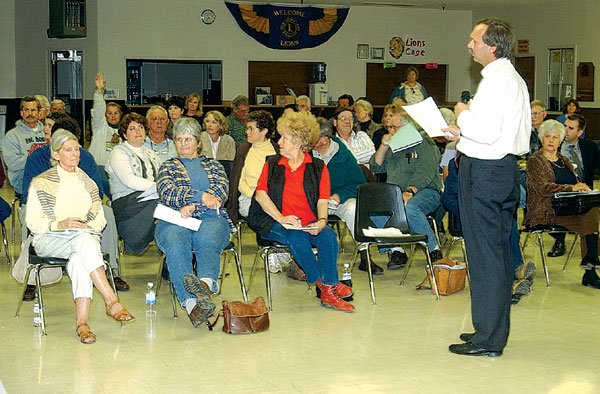San Martin – County officials came under siege Tuesday as they
tried to sort out the county’s controversial Williamson Act
policy.
About 50 real estate agents and property owners filled the
Lion’s Club in San Martin and took over a meeting that was supposed
to be an opportunity for official stakeholders to set down a
definition of commercial agriculture and establish criteria for
allowing land owners into the act.
San Martin – County officials came under siege Tuesday as they tried to sort out the county’s controversial Williamson Act policy.
About 50 real estate agents and property owners filled the Lion’s Club in San Martin and took over a meeting that was supposed to be an opportunity for official stakeholders to set down a definition of commercial agriculture and establish criteria for allowing land owners into the act.
But by the time introductions were over, the crowd was muttering, and a few slides into a presentation by the county’s agriculture commissioner, Greg Van Wassenhove, attendees made it clear they were not going to wait until the end of the meeting to air their views.
People didn’t want to hear about new applicants. They wanted reassurance that their contracts, and the significant tax breaks that go with them, are safe.
“Everyone has assumed that the contract particular to their property puts them in compliance, but now the rules change and people are sitting on dead horses,” said John Gormley, a real estate agent who also owns more than 700 acres on Finley Ridge in Morgan Hill. “How much more in compliance can a property be that has been in the same condition since the Williamson Act has been in existence?”
About 3,000 residents have Williamson contracts with the county. The contracts provide land owners with generous tax breaks in exchange for maintaining a legitimate agricultural enterprise or preserving specific types of open space. A change in policy will lead to some of those owners losing all or some of their protection under the act.
Before the county can determine who does and does not belong, though, it must lay out a definition of commercial agriculture. According to state law, people who raise ostriches and emus are farmers, but not those who raise horses, a point that raised a lot of hackles.
“There are many recreational use for horses, but there are also many viable agricultural uses of horses,” said Lydia Habenicht, a Realtor who breeds Arabian horses in San Martin. Habenicht said she fears the county is about to take away her clients’ property rights and said she doesn’t trust the county to enforce the act properly.
Complaints like that inspired a mea culpa from Lizanne Reynolds, deputy county counsel.
“The county has not properly administered the Williamson Act for many, many years,” Reynolds told the crowd. “We handed out contracts like candy, we didn’t enforce them, and we got busted.”
There are two types of landowners worried about a new policy. Those whose agriculture enterprises don’t meet income requirements under the act, and those who benefited from lax county oversight and subdivided and developed their parcels into non-compliance. Williamson contracts place strict limits on the number and size of subdivisions allowed and the size of houses and other non-agriculture structures that can be developed. Owners in violation may be subject to a fine as high as 25 percent of the market value of their land if they’re evicted from the act.
The act is managed county by county with ultimate oversight resting with the California Department of Conservation. A 2002 state audit found that the Santa Clara County allowed large tracts of land under Williamson contracts to be subdivided into smaller lots that were marketed or developed as home sites – in apparent contrast to the purpose of the act.
The county has been down this bumpy road before. In August 2003 the planning department proposed an ordinance to enforce the act that was met with such enmity from the public that the whole process was tabled – for 16 months.
Then in 2003, California legislators passed AB 1492, which raised the penalty for land owners caught subverting the act from 12.5 percent of the value of the undeveloped land to 25 percent of the value after development.
In response to all of that, county planners adopted the most stringent standards allowed by the state. They applied financial requirements reserved for crop land to grazing land, and insisted on income requirements that many say are too high.
Jenny Derry, executive director of the Santa Clara County Farm Bureau, called Tuesday’s meeting a “good first step.”
“I’m glad people got a chance to state their opinions,” Derry said. “We’ve heard it before, but it makes them feel better and it will help us going forward.”
Van Wassenhove said he will petition the state to allow horse breeding operations under the Williamson Act, but unlike ostriches, which can be eaten or made into purses, horses don’t meet the state’s definition of “food and fiber.” He said after the meeting that the next meeting should be a chance to fashion a final definition of agriculture and firm up the sketchy details he offered about requirements for future applications.
The hardest part, he said, will be figuring out if the criteria can be applied to existing contracts.
“We based most of our thoughts on the assumption that that Williamson contracts are all the same,” he said. “But I heard today that that might not be the case. The bulk of the contracts were made 10 years ago and earlier. I’ve never seen them.”
A date and time for the next meeting have not been set, but Van Wassenhove must report his progress to the county board of supervisors by April. The application process begins in July.
Guidelines county is using to evaluate act applications:
• Acreage: 10 acres prime land/40 acres non-prime land
• Income: $10,000 gross annual
• In use three of the last five years
• Verification through tax records, sales receipts, capital improvements
• Consideration of future income from planted, non-bearing crops
These are some of the proposed changes:
• 40 acres of prime land regardless of income
• 320 acres of non-prime land regardless of income
• $2,000 or more in income for cattle ranchers
• $10,000 or more in future income for planted, non-bearing crops such as fruits with as much as five or six years of no income.













